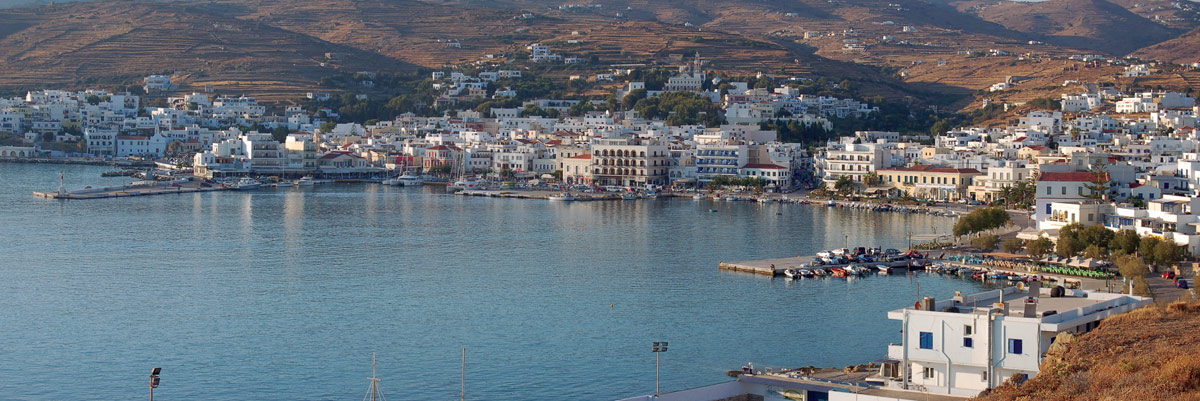
The name of Tinos is borne from her first resident, Tino. In ancient times there were other names, like Ydroúsa, which reveals that the island had lots of water, or Ofioúsa, most likely because of the multitude of snakes that existed here.
Tinos was one of the first islands of Greece to have inhabitants (8000 BC). The Cycladic civilization flourished around 3000-1000 BC so Tinos at that time had great economic and political prosperity.
During the Hellenic – Persian war, Tinos was forced to be on the Persian side and like the rest of the Cyclades, was already in the hands of the Persians for around a century. In the naval battle of Salamis (480 BC), at the critical moment, when the Greeks had not yet decide where to fight the Persians, one Tinian boat, with the Tinian captain Panaítios Sosiménis, divulged to the Greeks the Persian battle plans. This convinced the Greeks to fight the Persians in the strait of Salamína. For that heroic act, the Tinians were written in the Delphic Tripods, with other names of Greek cities.
Around the 3rd century BC, Tinos fell into the hands of the Macedonians and from then on there are few historical reports of the island, continuing through the Roman Empire.
In the Byzantine era, Arabians, Saracens and others from the Mediterranean plundered Tinos. During this period, many statues and temples were obliterated, whereas other places became the foundations of many Orthodox churches.
When the crusaders came and destroyed Constantinople (1204 AD), Tinos fell into the hands of Venice, and remained in their hands for 5 centuries. In this way, the island enjoyed the beneficial affect from the advanced western civilization, and was the only island in the Aegean to remain under Christian administration and far from the uncivilized Ottomans. Exómbourgo was a large castle hosting the central administration for the island, built during Venetian rule and even today is in good condition and worth a visit.
The 5th of June 1715, Tinos was the last Venetian and Christian island, surrendering to the Ottomans, who respected their society and institutions. So Tinos was not only under Ottomans supervision for less than a hundred years, since the Tinians took an early part in the Greek independence war 1821 (being one of the first cities to raise the Greek flag), but even for that one century the occupation was mild.
Tinos today is known as the island of Megalóharis (which means great grace), it is so-named because of the icon of Virgin Mary found during the Greek Independence War and comprised a good omen for its outcome. The icon was discovered after the visions first of an 80 year old islander and then by the nun Pelagía of the Koimísis Theotókou. On the 3rd of September the first litany of the icon took place.

Pánormos is a city with unknown history until medieval times. During the Venetian and Ottoman rule Pánormos was a very important harbour of Tinos, because most of the trades occurred there. In 1859 Pánormos was not only a port but it also became a mine. Marble and talc was quarried here. When the 2nd World War took place, the city was bombed and many houses as well as ships were destroyed.
Tinos (capital): Tinos is one of the newest cities of the island. It was build 1715, exactly when Tinos surrendered to the Ottomans. Before that, the capital was Exómbourgo, built on the rock of the same name. Some believe that the first residents of the city came around the 6th or 5th century BC, but others believe that the first residents of the city came around the 11th century BC (because of an Ionic wall was that was found).
In the Byzantine era, the city of Exómbourgo became the capital of the island Tinos and the Byzantines built a large castle so Tinos could defend itself against enemy attacks. Later, in the hands of the Venetians, the castle was renovated. Towers were built looking towards every direction as well as 600 metres of walls. They called it «Castello di Santa Elena».
The first Ottoman attack on the castle transpired in 1570 and the castle successfully defended the assault. The Ottomans attempted 4 times still to penetrate the castle, but in all 4 endeavours failed. The only successful attempt was in 1715, when only 14 mean were left defending the castle.
Absolutely visit the church of Evangelístria. Thousands come all year to worship the magnificent icon of Virgin Mary. In the temple, apart from the icon, admire the many votives some of which are from famous people.


